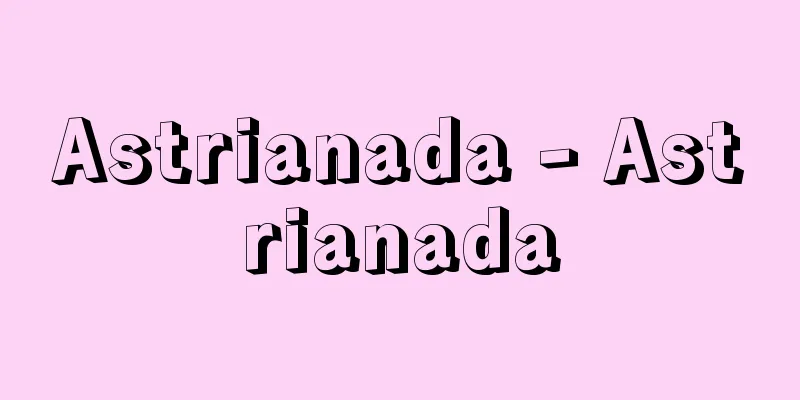Weaning - Weaning

|
This refers to the process of feeding infants who are only getting their nutrition from breast milk a variety of semi-solid foods, gradually increasing their hardness and quantity, and transitioning them to solid food forms for infants. Weaning is complete when the main source of nutrition becomes foods other than breast milk. The expression "weaning" was used in the past, with emphasis on the timing of weaning, but it has become mainstream to avoid stressing infants and wean them naturally regardless of the timing, and the term "weaning" is now used. The first food given to babies as weaning food varies widely and is closely related to the eating habits of each ethnic group. In southern countries, bananas are used, while highland peoples who eat potatoes as their staple food chew potatoes before giving them to their babies. Also, ethnic groups such as the Eskimos who regularly eat raw meat give it to their babies as weaning food. In any case, the time when weaning begins seems to differ depending on the food given, and it can be said that each ethnic group has its own rational way of proceeding with weaning. In the past, the general approach to weaning was "food-centered," which focused on what foods to feed, when, and in what order. However, Takeshi Futaki (1925-1998), a physician known for his research into nutritional foods for weaning, argued for a "cooking form ideology," in which the type, order, and arrangement of foods are completely meaningless, and what is important is that whatever ingredients are used, they should be cooked in a way that is easy for infants to accept. He said that the key to weaning is acquiring the ability to chew. Therefore, the basic approach to weaning is to progress from soft to hard foods, gradually increase the amount, and provide a balanced diet. [Hoashi Eiichi] When to start weaningAs a guideline, around 5 months of age is considered appropriate, but it is best to take individual differences into consideration and respect each child's individuality by starting earlier for children who are growing quickly and have a good appetite and later for those who do not. [Hoashi Eiichi] How to proceed with weaningWhen weaning, start by feeding once a day around 10 am before the baby is hungry to feed. Add one new food at a time, not more than two at a time. Increase the amount by one spoonful per day, proceeding carefully while observing the baby's stool and general condition. The cooking form should be changed according to the development of the baby's chewing and swallowing abilities. In the early stages (5-6 months), a paste-like consistency that has been strained through a sieve is desirable, in the middle stages (7-8 months), a consistency that can be crushed with the tongue, and in the later stages (9-11 months), a consistency that can be crushed with the gums. Food groups such as grains, vegetables, and protein should be given while considering nutritional balance. Also, remember to use light seasoning and low salt, and to handle the food cleanly. The principle of weaning is to proceed while taking into consideration the child's developmental stage. Ignoring this and proceeding only with consideration of the child's age will often lead to difficulties. It is particularly important to change the cooking method according to the development of the child's chewing and swallowing abilities. Also, just like breastfeeding, it is important to proceed with weaning while recognizing that it is a fun time for both the mother and the child and a process that deepens the mother-child relationship. [Hoashi Eiichi] [Reference] | |Source: Shogakukan Encyclopedia Nipponica About Encyclopedia Nipponica Information | Legend |
|
乳汁のみで栄養をとっている乳児に、種々の半固形食を与え、しだいにその硬度と量を増し、幼児の固形食形態に移していく過程をいう。離乳完了とは、おもな栄養源が、乳汁以外の食物になる時期をもっていう。離乳すべき時期を重視して「断乳」という表現も用いられていたが、乳児にストレスを与えることを避け、時期にこだわらず自然に離乳を行うことが主流となり、「卒乳」ということばが使われるようになっている。 離乳食として最初に与える食品は、各民族の食習慣と密着しており、さまざまである。南方諸国ではバナナを用い、イモを主食とする高地民族は、イモをかんで与えるという。またエスキモーのように生肉を常食する民族では、それを離乳食に与えるという。いずれにしても、その与える素材によって、離乳開始時期も異なるようで、その民族なりの合理的な離乳の進め方が定着しているとみてよい。 離乳の進め方については、従来はどういう食品をいつごろから、どういう順序で与えるかという「食品中心主義」が一般的であった。これに対して離乳栄養食の研究で知られる医師の二木武(ふたきたけし)(1925―1998)は、食品の種類、順序、配列にはまったく意味がなく、たいせつなのは、どのような素材であっても、乳児に受け入れやすい形に調理してさえあればよいという、「調理形態主義」を主張し、離乳のポイントがそしゃく能力の獲得にあるとしている。したがって離乳の進め方は、調理形態で軟らかいものから硬いものへと進めること、量を少しずつ増やしていくこと、栄養のバランスをとって与えることが基本となる。 [帆足英一] 離乳の開始時期目安としては、生後5か月ごろが妥当と考えられるが、あくまで個人差を考慮し、発育の速やかな、食欲の旺盛(おうせい)な子は早めに、そうでない子は遅めにと、個性を尊重することが望ましい。 [帆足英一] 離乳の進め方離乳を始めるときは、乳児の空腹な哺乳(ほにゅう)前の午前10時前後に、1日1回から開始する。新しい食品は、1種類ずつ増やし、同時に2種以上の食品を増やさない。分量は、1日1さじずつ増やし、便性や子供の一般状態を見ながら慎重に進める。調理形態としては、そしゃく能力や嚥下(えんげ)能力の発達に応じて変化させ、初期(5~6か月)は裏漉(うらご)ごししたペースト状のどろどろ、中期(7~8か月)は舌でつぶせるつぶつぶの固さ、後期(9~11か月)は歯ぐきでつぶせる程度の固さを目安に進めることが望ましい。食品群としては、穀類、野菜、タンパク質などを、栄養のバランスを考慮して与える。また薄味にして塩分を少なくすること、清潔に扱うことを忘れてはならない。 離乳のステップは、あくまで子供の発達段階を考慮しながら進めることが原則であり、それを無視し、月齢のみを考慮して進めるとつまずくことが多い。とくにそしゃく能力、嚥下能力の発達に応じて、調理形態を変化させていくことが必要である。また、授乳と同様、母親にとっても子供にとっても、離乳が楽しいひとときであり、母子関係を深めていく一つの過程であることを認識して進めていくことがたいせつである。 [帆足英一] [参照項目] | |出典 小学館 日本大百科全書(ニッポニカ)日本大百科全書(ニッポニカ)について 情報 | 凡例 |
>>: Linear motor car - ri-na-mo-ta-ka- (English spelling) linear motor car
Recommend
Hering-Breuer's reflex
It is also called the pulmonary vagal respiratory ...
Izumi Kyoka
Novelist. Born November 4, 1873 in Kanazawa, Ishi...
Totemism - totemism
It refers to the belief in totems and the system ...
Gyoki-zu
This is a map of Japan that is said to have been ...
Anzu - Business
An accessory to horse harness or armor. It is tho...
Reichsreform
This refers to reforms of the Holy Roman Empire at...
Yuni [town] - Yuni
A town in Yubari County, Hokkaido. The central set...
Nymphasea caerulea (English spelling) Nymphaseacaerulea
…Lotus [Motomi Ito]. … *Some of the terminology t...
Craniospinal nervous system
The peripheral nervous system is the nervous syst...
Markovnikov's rule
This is an empirical rule regarding the direction ...
Pronolagus
…General term for mammals of the Palaeolaginae su...
pollucite
...The following minerals are called rare element...
《Seashell》
...The main industries are the cultivation of fru...
Kokichi Kano
Philosopher. Born in Odate, Dewa Province (Akita ...
United States Court of Appeals for the circuit
… [In Europe and the US] A three-tiered court sys...









